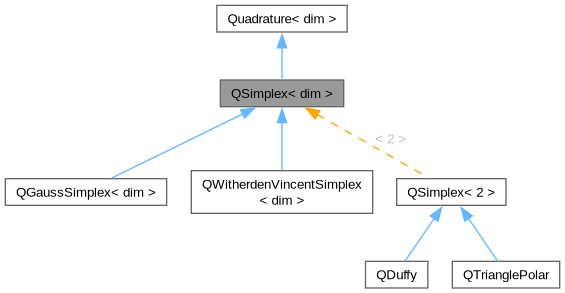 |
Reference documentation for deal.II version 9.6.0
|
 |
Reference documentation for deal.II version 9.6.0
|
#include <deal.II/base/quadrature_lib.h>

Public Member Functions | |
| QSimplex (const Quadrature< dim > &quad) | |
| template<int spacedim = dim> | |
| Quadrature< spacedim > | compute_affine_transformation (const std::array< Point< spacedim >, dim+1 > &vertices) const |
| template<int spacedim = dim> | |
| Quadrature< spacedim > | mapped_quadrature (const std::vector< std::array< Point< spacedim >, dim+1 > > &simplices) const |
Given an arbitrary quadrature formula, return one that chops the quadrature points above the hyper-plane defined by \sum_i x_i = 1. In other words, it extracts those quadrature points from the base formula that satisfy \sum_i (\mathbf x_q)_i \le 1+10^{-12}."
In general the resulting quadrature is not very useful, unless the quadrature you started from has been constructed specifically to integrate over triangles or tetrahedra. This class only ensures that the resulting quadrature formula only has quadrature points in the reference simplex or on its boundary.
No transformation is applied to the weights, and the weights referring to points that live outside the reference simplex are simply discarded. Because this leads to (or may lead to) a sum of quadrature weights that do not equal the area of the simplex, the resulting quadrature formula is not useful for actually computing integrals.
The main use of this quadrature formula is not to chop tensor product quadratures. Ideally you should pass to this class a quadrature formula constructed directly using points and weights in the reference simplex, capable of integrating on triangles or tetrahedra.
For finite elements based on quadrilaterals and hexahedra, a QSimplex quadrature formula is not very useful on its own. This class is typically used in conjunction with other classes, like QSplit, to patch the reference element using several QSimplex quadrature formulas.
Such quadrature formulas are useful to integrate functions with singularities at certain points, or functions that present jumps along a co-dimension one surface inside the reference element, like in the extended finite element method (XFEM).
Definition at line 668 of file quadrature_lib.h.
| QSimplex< dim >::QSimplex | ( | const Quadrature< dim > & | quad | ) |
Construct a quadrature that only contains the points that are in the lower left reference simplex.
| [in] | quad | The input quadrature. |
Definition at line 1446 of file quadrature_lib.cc.
| Quadrature< spacedim > QSimplex< dim >::compute_affine_transformation | ( | const std::array< Point< spacedim >, dim+1 > & | vertices | ) | const |
Return an affine transformation of this quadrature, that can be used to integrate on the simplex identified by vertices.
Both the quadrature point locations and the weights are transformed, so that you can effectively use the resulting quadrature to integrate on the simplex.
The transformation is defined as
x = v_0 + B \hat x
where the matrix B is given by B_{ij} = v[j][i]-v[0][i].
The weights are scaled with the absolute value of the determinant of B, that is J \dealcoloneq |\text{det}(B)|. If J is zero, an empty quadrature is returned. This may happen, in two dimensions, if the three vertices are aligned, or in three dimensions if the four vertices are on the same plane. The present function works also in the codimension one and codimension two case. For instance, when dim=2 and spacedim=3, we can map the quadrature points so that they live on the physical triangle embedded in the three dimensional space. In such a case, the matrix B is not square anymore.
| [in] | vertices | The vertices of the simplex you wish to integrate on |
Definition at line 1473 of file quadrature_lib.cc.
| Quadrature< spacedim > QSimplex< dim >::mapped_quadrature | ( | const std::vector< std::array< Point< spacedim >, dim+1 > > & | simplices | ) | const |
Given a collection of simplices, this function creates a global quadrature rule on the area covered by the simplices, by mapping the current quadrature on each simplex. A simplex is identified by its vertices, which are stored into an array of Points. Hence, this function can provide quadrature rules on polygons (or polyhedra), as they can be split into simplices.
| simplices | A std::vector where each entry is an array of dim+1 points, which identifies the vertices of a simplex. |
Definition at line 1507 of file quadrature_lib.cc.